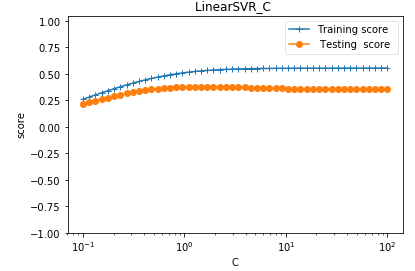吴裕雄 python 机器学习——支持向量机线性回归SVR模型
import numpy as np
import matplotlib.pyplot as plt from sklearn import datasets, linear_model,svm
from sklearn.model_selection import train_test_split def load_data_regression():
'''
加载用于回归问题的数据集
'''
diabetes = datasets.load_diabetes() #使用 scikit-learn 自带的一个糖尿病病人的数据集
# 拆分成训练集和测试集,测试集大小为原始数据集大小的 1/4
return train_test_split(diabetes.data,diabetes.target,test_size=0.25,random_state=0) #支持向量机线性回归SVR模型
def test_LinearSVR(*data):
X_train,X_test,y_train,y_test=data
regr=svm.LinearSVR()
regr.fit(X_train,y_train)
print('Coefficients:%s, intercept %s'%(regr.coef_,regr.intercept_))
print('Score: %.2f' % regr.score(X_test, y_test)) # 生成用于回归问题的数据集
X_train,X_test,y_train,y_test=load_data_regression()
# 调用 test_LinearSVR
test_LinearSVR(X_train,X_test,y_train,y_test)

def test_LinearSVR_loss(*data):
'''
测试 LinearSVR 的预测性能随不同损失函数的影响
'''
X_train,X_test,y_train,y_test=data
losses=['epsilon_insensitive','squared_epsilon_insensitive']
for loss in losses:
regr=svm.LinearSVR(loss=loss)
regr.fit(X_train,y_train)
print("loss:%s"%loss)
print('Coefficients:%s, intercept %s'%(regr.coef_,regr.intercept_))
print('Score: %.2f' % regr.score(X_test, y_test)) # 调用 test_LinearSVR_loss
test_LinearSVR_loss(X_train,X_test,y_train,y_test)

def test_LinearSVR_epsilon(*data):
'''
测试 LinearSVR 的预测性能随 epsilon 参数的影响
'''
X_train,X_test,y_train,y_test=data
epsilons=np.logspace(-2,2)
train_scores=[]
test_scores=[]
for epsilon in epsilons:
regr=svm.LinearSVR(epsilon=epsilon,loss='squared_epsilon_insensitive')
regr.fit(X_train,y_train)
train_scores.append(regr.score(X_train, y_train))
test_scores.append(regr.score(X_test, y_test))
fig=plt.figure()
ax=fig.add_subplot(1,1,1)
ax.plot(epsilons,train_scores,label="Training score ",marker='+' )
ax.plot(epsilons,test_scores,label= " Testing score ",marker='o' )
ax.set_title( "LinearSVR_epsilon ")
ax.set_xscale("log")
ax.set_xlabel(r"$\epsilon$")
ax.set_ylabel("score")
ax.set_ylim(-1,1.05)
ax.legend(loc="best",framealpha=0.5)
plt.show() # 调用 test_LinearSVR_epsilon
test_LinearSVR_epsilon(X_train,X_test,y_train,y_test)

def test_LinearSVR_C(*data):
'''
测试 LinearSVR 的预测性能随 C 参数的影响
'''
X_train,X_test,y_train,y_test=data
Cs=np.logspace(-1,2)
train_scores=[]
test_scores=[]
for C in Cs:
regr=svm.LinearSVR(epsilon=0.1,loss='squared_epsilon_insensitive',C=C)
regr.fit(X_train,y_train)
train_scores.append(regr.score(X_train, y_train))
test_scores.append(regr.score(X_test, y_test))
fig=plt.figure()
ax=fig.add_subplot(1,1,1)
ax.plot(Cs,train_scores,label="Training score ",marker='+' )
ax.plot(Cs,test_scores,label= " Testing score ",marker='o' )
ax.set_title( "LinearSVR_C ")
ax.set_xscale("log")
ax.set_xlabel(r"C")
ax.set_ylabel("score")
ax.set_ylim(-1,1.05)
ax.legend(loc="best",framealpha=0.5)
plt.show() # 调用 test_LinearSVR_C
test_LinearSVR_C(X_train,X_test,y_train,y_test)

吴裕雄 python 机器学习——支持向量机线性回归SVR模型的更多相关文章
- 吴裕雄 python 机器学习——支持向量机非线性回归SVR模型
import numpy as np import matplotlib.pyplot as plt from sklearn import datasets, linear_model,svm fr ...
- 吴裕雄 python 机器学习——支持向量机SVM非线性分类SVC模型
import numpy as np import matplotlib.pyplot as plt from sklearn import datasets, linear_model,svm fr ...
- 吴裕雄 python 机器学习——支持向量机线性分类LinearSVC模型
import numpy as np import matplotlib.pyplot as plt from sklearn import datasets, linear_model,svm fr ...
- 吴裕雄 python 机器学习——层次聚类AgglomerativeClustering模型
import numpy as np import matplotlib.pyplot as plt from sklearn import cluster from sklearn.metrics ...
- 吴裕雄 python 机器学习——密度聚类DBSCAN模型
import numpy as np import matplotlib.pyplot as plt from sklearn import cluster from sklearn.metrics ...
- 吴裕雄 python 机器学习——KNN回归KNeighborsRegressor模型
import numpy as np import matplotlib.pyplot as plt from sklearn import neighbors, datasets from skle ...
- 吴裕雄 python 机器学习——KNN分类KNeighborsClassifier模型
import numpy as np import matplotlib.pyplot as plt from sklearn import neighbors, datasets from skle ...
- 吴裕雄 python 机器学习——半监督学习LabelSpreading模型
import numpy as np import matplotlib.pyplot as plt from sklearn import metrics from sklearn import d ...
- 吴裕雄 python 机器学习——线性回归模型
import numpy as np from sklearn import datasets,linear_model from sklearn.model_selection import tra ...
随机推荐
- 栈和队列----将单链表的每K个节点之间逆序
将单链表的每K个节点之间逆序 给定一个单链表的头节点head,实现一个调整链表的函数,使得每K 个节点之间逆序,如果最后剩下不够K 个节点,则不调整最后几个. 例如: 链表:1—>2—>3 ...
- 6.Dockerfile 指令
概述 我们已经介绍了 FROM,RUN,还提及了 COPY, ADD,其实 Dockerfile 功能很强大,它提供了十多个指令.下面我们继续讲解其他的指令. COPY 格式: COPY <源路 ...
- Qt Gui 第一章~第二章
一.Qt启动 qmake -project; 创建xxx.pro qmake xxx.pro; 生成makefile文件 make:构建该程序,生成可执行文件 运行程序:windows:xxx:mac ...
- TD - 输入框
模板1:TD - 普通输入框 <input dojoType="bootstrap.form.ValidationTextBox" dojoAttachPoint=" ...
- javaScript入门(函数)
目录 JavaScript函数 函数是什么 函数返回值 return特点: 递归函数 匿名函数(anoymous) 自执行函数(通过匿名函数实现) 回调函数 闭包函数 构造函数 构造函数两大类 注意事 ...
- js获取自定义data属性
<!DOCTYPE html> <html> <head lang="en"> <meta charset="UTF-8&quo ...
- monkey log 处理
Monkey结果输出 1.保存在pc中 adb shell monkey [option] <count> >d:\monkey.txt 2.保存在手机中 adb shell mon ...
- 题解【CJOJ1071/UVA】硬币问题
P1071 - [Uva]硬币问题 Description 有n种硬币,面值分别为v1, v2, ..., vn,每种都有无限多.给定非负整数S,可以选用多少个硬币,使得面值之和恰好为S?输出硬币数目 ...
- JS实现点击table中任意元素选中
上项目开发,忙的焦头烂额,博客也没咋更新了. 昨天老师提了个需求,简单的小例子,选择tr中任一行选中tr,觉得很有意思,记录一下: 上代码 <!DOCTYPE html> <html ...
- apache 二级域名设置
1. 你要拥有一个有泛域名解析的顶级域名,例如:test.com 在dns服务上设置,域名服务商都提供此服务 www.test.com 指向服务器IPtest.com 指向 ...
